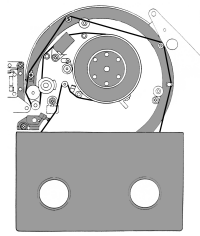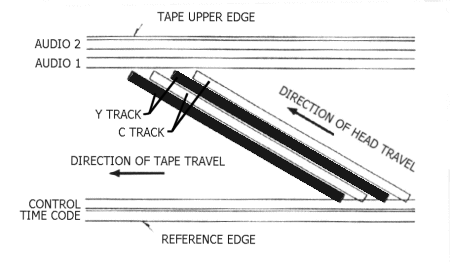Designed by Sony in the 1980's the Betacam format became the de-facto broadcast video format world-wide. It's derivatives Betacam SP (Superior Performance), Digital Betacam and Betacam SX are at the forefront of video technology. The small format Betacam tapes are identical in size to Betamax tapes and some can be used in Betamax machines, but it is at this point that the similarity ends.
Betacam is a high quality format based apon the component video standard. In this system a video signal is represented by three signals. One Luminance and two Chrominance. These signals are referred to as Y, U and V and are no more than a special way of encoding the Red, Green and Blue signals that make up all colour images. Unlike, it's predecessors such as the U-matic format, the Betacam format records all three signals independently so that there is minimal signal loss during the record/playback process. It is able to do this by using a process known as Compressed Time Division Multiplex (CTDM).
The signal carrying the colour information, U and V, is time compressed and recorded on to one video track while the luminance, or Y, signal is recorded onto a second track. The use of two separate tracks eliminates the cross colour and cross luminance effects inherent in composite recording. Both tracks are recorded using high frequency FM (frequency modulated) carriers. This allows for high bandwidth for the Luminance and Chrominance signals.
The format uses 1/2-inch tape which runs at the high speed of 101.5mms. To increase running times to beyond 90 minutes a large format tape cassette was introduced. All the studio machines are capable of accepting both size of cassette without a need for any adapter.
The format was designed for professional use and so advanced features such as Time Code and full editing functionality were built into the system from the start.

Tape wrap

Betacam SP head layout
| Basic Betacam System Data | |
|---|---|
| Tape Width | 1/2 inch |
| Drum Diameter | 2.9 inch |
| Speed of Head Disc | 1800 rpm |
| Tape Speed (PAL) | 101.5 mms-1 |
| Head gap width | Y: 85µm, C 73µm, Erase 160µm |
| Y Track Width | 86µm |
| C Track Width | 73µm |
| Guard band width | Y to C same pair: 1.0µm Y to C different pairs: 5.7µm |
| Maximum Recording Time (PAL) | 90 mins approx |
| Component S/N Ratio | > 46dB |
| Angle of Video Tracks | 4.6811° |
| FM Deviation | Y: 4.4-6.4MHz C:4.0-5.7MHz |
| FM Deviation SP format | Y: 6.8-8.8MHz C:5.6-7.3MHz |
| Colour recording system | CTDM |
| End Sensors | Optical |
| Audio Track Width (1&2) | 1.93 mm |
| Audio Guard band width | 0.4 mm |
| Audio Frequency Response | 50Hz - 15kHz Linear Tracks 50Hz - 20kHz FM Tracks |
| FM Audio carrier frequencies | 310 & 540 kHz |
| Control Track Width | 0.4 mm |
| Timecode Track Width | 0.4 mm |
The format has developed during its lifetime. Sony has brought out several model ranges of machines over the years to take advantage of new developments in tape and video technology.
There are currently four Betacam variants: Betacam,
The original series of Betacam SP VTRs is the BVW series of machines. In 1993 Sony released the UVW series to be followed later by the PVW series.
The UVW were the first series of budget machines. Heralded as 'Betacam for the masses' the launch of the UVW range brought the Betacam SP format within reach of many who until then had been unable to afford the high cost of the BVW series machines. The UVW machines lack many of the advanced features of the BVW series, such as AFM audio tracks, Dynamic tracking and VITC (Vertical Interval Time Code). The PVW series is intended to fill this gap and provide many of these features at a very economic price.
As time goes by, many of the original Betacam SP machines are becoming available at very competitive second-hand prices.

